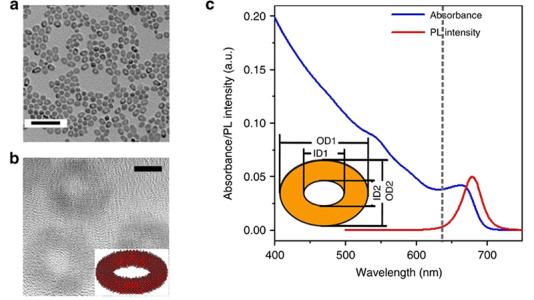
Scientific Achievement
A peculiar in-plane uniaxial transition dipole was discovered in a two-dimensional semiconductor quantum ring caused by a broken rotational symmetry. Semiconductor quantum rings are topological structures that are relevant to research on quantum information devices. The annular shape of these rings distinguishes them from other low-dimensional materials, and this enables topologically induced properties such as geometry-dependent spin manipulation and emission. While optical transition dipole moments (TDMs) in zero- to two-dimensional optical emitters have been well investigated, those in quantum rings remain obscure despite their importance to the quantum photonic application of quantum rings. Using optical spectroscopy, the dimensionality and orientation of TDMs in CdSe quantum rings was determined. In contrast to other two-dimensional optical emitters, the TDMs in CdSe quantum rings show a peculiar in-plane linear distribution. Theoretical modeling revealed the uniaxial TDM originates from broken rotational symmetry.
Significance and Impact
This finding may enable the development of a new class of quantum materials that exploit optical spin-orbit coupling through geometry engineering.
Research Details
- Optical transition dipole moments of CdSe quantum rings were measured with angle-resolved photoluminescence spectroscopy and high-order scanning laser microscopy at the Center for Nanoscale Materials (CNM) and LMU.
- Empirical tight-binding calculations of the wavefunctions in CdSe quantum rings were performed at CNM and University of Ottawa; broken rotational symmetry was found to induce uniaxial transition dipole moments.
Work was performed in part at CNM.
About Argonne’s Center for Nanoscale Materials
The Center for Nanoscale Materials is one of the five DOE Nanoscale Science Research Centers, premier national user facilities for interdisciplinary research at the nanoscale supported by the DOE Office of Science. Together the NSRCs comprise a suite of complementary facilities that provide researchers with state-of-the-art capabilities to fabricate, process, characterize and model nanoscale materials, and constitute the largest infrastructure investment of the National Nanotechnology Initiative. The NSRCs are located at DOE’s Argonne, Brookhaven, Lawrence Berkeley, Oak Ridge, Sandia and Los Alamos National Laboratories. For more information about the DOE NSRCs, please visit https://science.osti.gov/User-Facilities/User-Facilities-at-a-Glance.
Argonne National Laboratory seeks solutions to pressing national problems in science and technology. The nation’s first national laboratory, Argonne conducts leading-edge basic and applied scientific research in virtually every scientific discipline. Argonne researchers work closely with researchers from hundreds of companies, universities, and federal, state and municipal agencies to help them solve their specific problems, advance America’s scientific leadership and prepare the nation for a better future. With employees from more than 60 nations, Argonne is managed by UChicago Argonne, LLC for the U.S. Department of Energy’s Office of Science.
The U.S. Department of Energy’s Office of Science is the single largest supporter of basic research in the physical sciences in the United States and is working to address some of the most pressing challenges of our time. For more information, visit https://energy.gov/science.